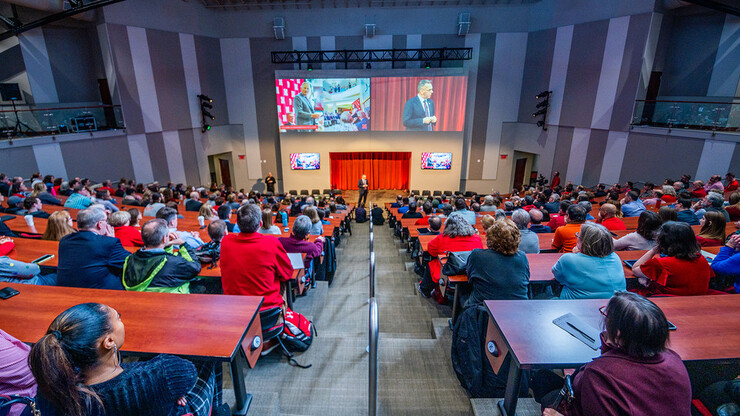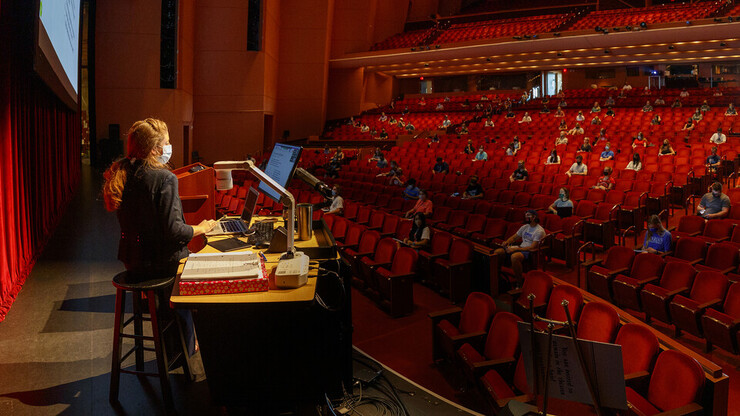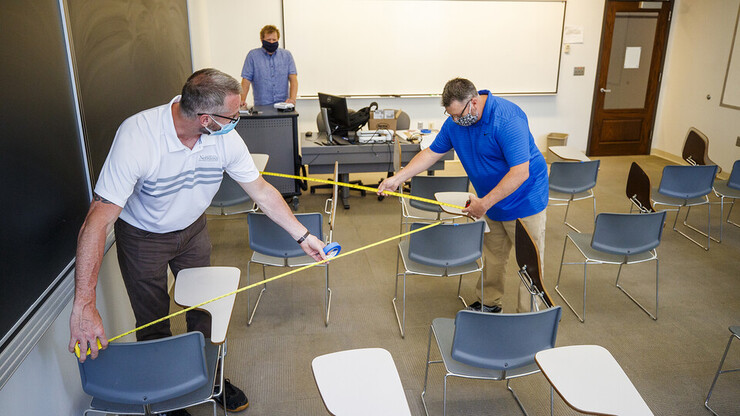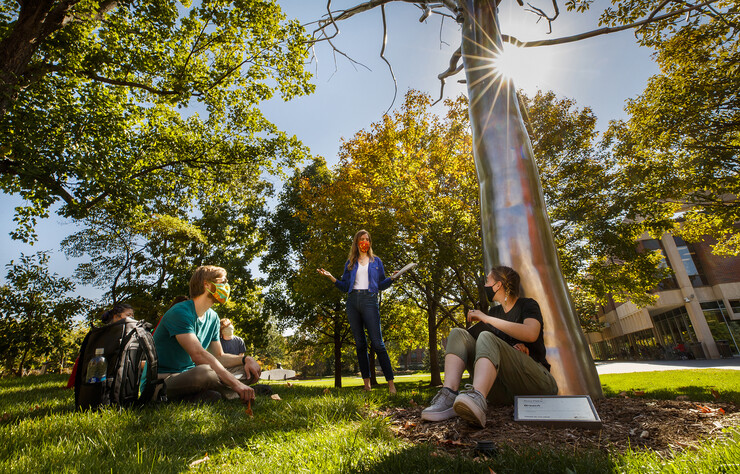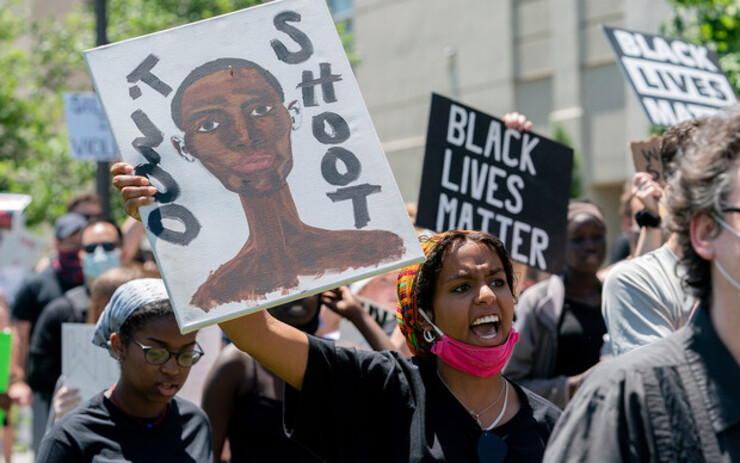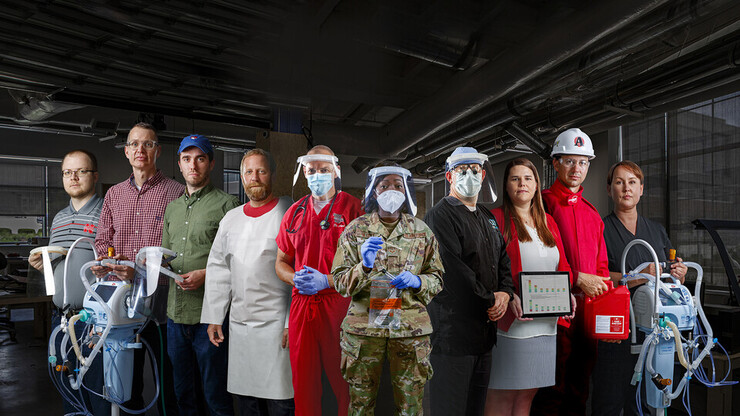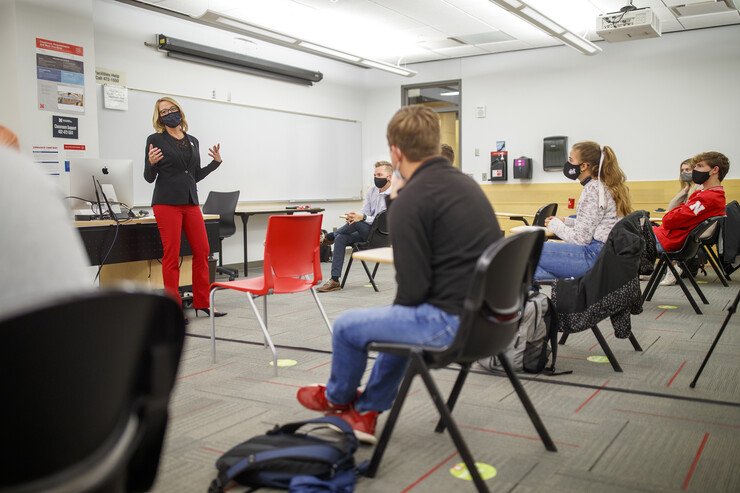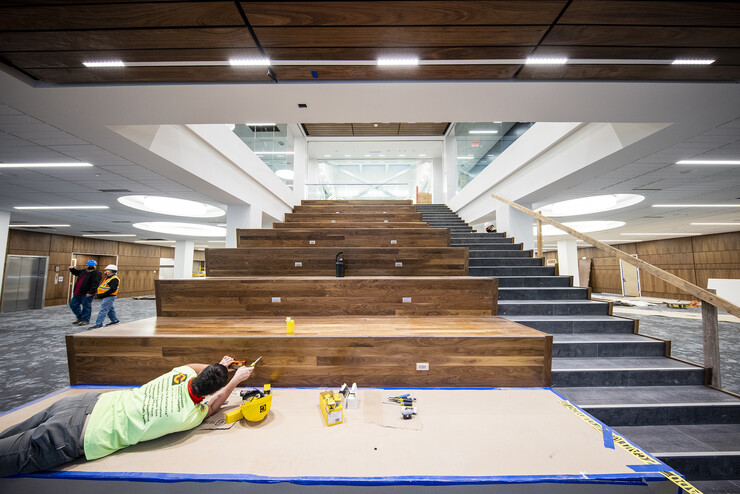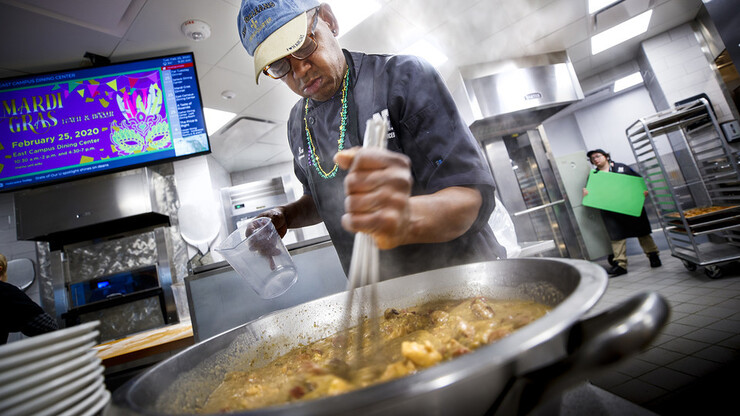· 11 min read
2020: A year like no other
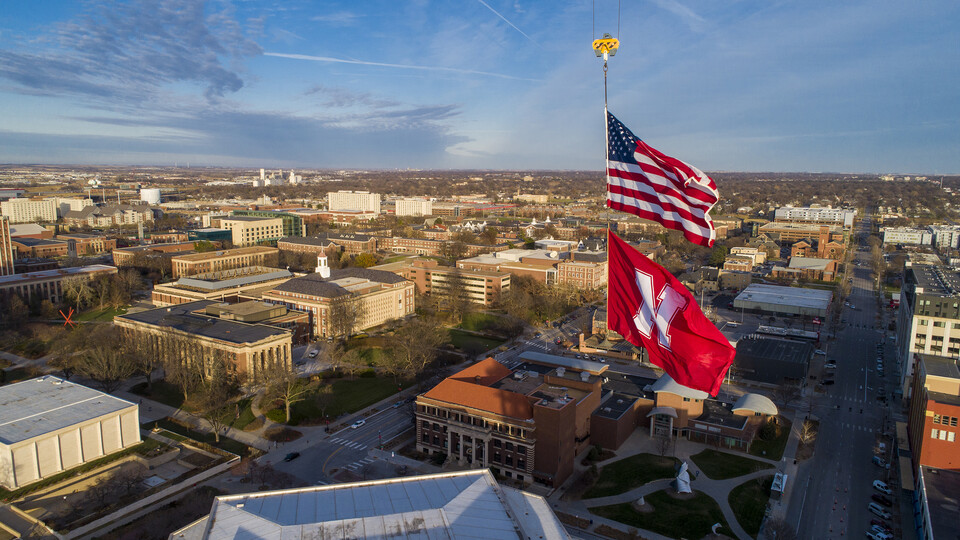
How do you begin to sum up a year like 2020?
For many, the COVID-19 pandemic will be remembered as the darkest moment of a lifetime. More than 300,000 Americans have been lost to the virus. Millions more have dealt with unemployment and financial struggles, and nearly everything about how we live, work and connect with one another has shifted.
Yet, in the unparalleled circumstances of the past year, Huskers rose up. Staff members stretched their strengths and put in long hours to make safe, in-person instruction a reality. Faculty got creative to implement new methods of teaching and learning. Students masked up and made the best of a new way of campus life.
That collective commitment allowed the university’s mission of education, outreach and research to continue on — and reminded us that there really is no place like Nebraska.
Bold beginnings
2020 started off like any other year at the university. Students cheered on the Husker basketball team at Pinnacle Bank arena, celebrated Black History Month and ate at the Nebraska East Union’s new dining center. No one would have guessed how fondly we’d look back on those ordinary moments mere months later.
The beginning of the year was an especially ambitious time for Nebraska, with Chancellor Ronnie Green hosting his second-annual State of Our University Address Feb. 14. At the event, Green unveiled the N2025 Strategic Plan, which charts a course for the university over the next five years. The plan set goals for growth in graduation and retention rates and increases in research expenditures and experiential learning opportunities for all students, among others.
A historical pivot
The first case of a new coronavirus was identified in Wuhan, China, in December 2019. By Feb. 11, the associated respiratory illness had a name — COVID-19 — and on March 11, the World Health Organization declared a pandemic as the virus began to spread within the United States.
Chancellor Green recalls Feb. 26 as one of the last normal days of 2020.
“I remember the sense of alarm I felt as I listened to my colleague, UNMC Chancellor Jeff Gold, describe a very dire situation that would likely unfold globally, nationally and locally,” Green wrote in a blog post. “That sense of fear grew as the subsequent two weeks played out — more and more evidence accumulated showing a real threat to our university, and our UNL leadership team went in to full ‘war room’ mode of planning.”
Nebraska announced it would cancel in-person classes and shift to remote instruction on March 12, joining a wave of other universities sending students home. Many Huskers packed up their things and left Lincoln, while some who were unable to do so remained in campus housing.
Faculty and staff pivoted to record lectures and labs for students, finding new ways to keep learning going from a distance. The spring semester closed with the university hosting its first-ever virtual graduation celebration on May 9.
In May, attention turned toward how students could be brought back safely for the fall semester, leading to the launch of the universitywide Forward to Fall effort. Over the summer, staff members put in long hours to prepare campus for in-person instruction. Jim Jackson, associate vice chancellor of university operations, led the creation of more than 1,000 custom hand-sanitizer stations. Facilities workers mapped out nearly 350 classrooms and more than 400 lab spaces for social distancing, and nearly 260 air-handling systems were adjusted for enhanced ventilation and filtration. The university’s first on-campus testing site also opened in the 17th and R parking garage that August.
That preparation paid off on Aug. 24, the first day of in-person instruction for the fall semester. Many faculty members chose to teach outdoors to mitigate the virus spread, and the Lied Center for Performing Arts was even transformed into a lecture hall.
“I have seen students roll with the situation and make these accommodations and wear their masks and chime in to Zoom and do their assignments,” said Cynthia Cress, associate professor of special education and communication disorders. “They have stepped up to the plate to be responsible scholars and citizens. And I’m proud of them.”
There were glimmers of normalcy during the fall semester, too — Registered Student Organizations continued to meet, and students, faculty and staff found connection through virtual events. Football Saturdays even returned, with the Huskers playing at a nearly empty Memorial Stadium.
The accelerated semester continued without interruption through Nov. 25, the last day of finals.
Though there were many bright spots throughout the past nine months, Nebraska wasn’t immune to the effects of the pandemic. The university’s quarantine preparations were put to the test when several clusters of COVID-19 appeared in the student population. Nearly $39 million will also be cut from the university’s budget through 2023, accounting for shortfalls in revenue.
“I truly believe that we will emerge from this period with a clear reaffirmation of our purpose and value as an institution,” Green said in August. “It is nonetheless important that we also plan in a thoughtful and responsive manner for the period ahead of us.”
Calls for racial justice
On May 25, George Floyd, a 46-year-old Black man, was killed by police in Minneapolis. Video of Floyd’s death spread online, sparking months-long protests in Lincoln and more than 150 American cities.
In response to nationwide calls for racial justice, Green announced a new “Journey to Equity” at the university on June 5. The journey is currently being guided by Marco Barker, vice chancellor for diversity and inclusion, along with five faculty members on campus. While its initiatives are still being finalized, they include examining how core curriculum addresses race, privilege and power; prioritizing research in those areas; developing a clearer and more transparent process for addressing climate issues; and reviewing community policing efforts.
Along with participating in protests during the summer, members of Nebraska’s Black Student Union took action by creating care bags for members of the Lincoln community. Fellow Huskers helped chip in $14,000 for the effort.
“It really speaks to how Lincoln feels and is willing to stand with the Black Lives Matter movement and with initiatives that will help uplift our community,” said Batool Ibrahim, president of the organization.
Unstoppable research
During the pandemic, many Husker researchers dedicated their time and resources toward COVID-19-related issues. Their ingenuity yielded 21,000 face shields for health care workers, 200,000 gallons of donated hand sanitizer, an engineering solution for sharing ventilators, a contract tracing smartphone app, a series of educational comics and a study on how the virus has impacted older minority and immigrant populations.
Research unrelated to COVID-19 also continued strong in 2020. Key studies and findings in the physical and social sciences include:
- The discovery of the world’s highest-elevation mammal, a yellow-rumped leaf-eared mouse, on top of a dormant volcano in South America. Jay Storz, Willa Cather Professor of biological sciences, led the expedition alongside mountaineer Mario Pérez Mamani.
- A promising vaccine candidate for the sexually transmitted herpes simplex virus 2.
- An answer for why the front nose of a football — which points upward when it leaves a quarterback’s hand — tilts downward by the time it lands in the hands of a receiver. The sports-related research was led by Tim Gay, Willa Cather Professor of physics and astronomy.
- An ongoing, five-year study seeking to measure how executive control abilities correlate with obesity in adolescence.
- “One More Voice,” a project that sheds light on the non-European individuals who assisted the quests of famed Victorian explorers such as David Livingstone and Henry Morton Stanley.
New leadership
2020 brought a host of new faces to campus. Notable leadership appointments include:
- Elizabeth Spiller, executive vice chancellor for academic affairs
- Shari Veil, dean of the College of Journalism and Mass Communications
- Hasan Ramzah, chief of police
- Kelli King, assistant vice chancellor for student affairs
- Patrick Winter, associate vice chancellor for academic services and enrollment management
- Jake Johnson, associate to the chancellor for institutional equity and compliance
Breaking ground
Construction projects on campus continued to steadily progress in 2020. The Nebraska East Union’s $28.5 million renovation was completed during the fall semester, and the Dinsdale Family Learning Commons — a new community space which was formerly the C.Y. Thompson Library — is scheduled to open in January 2021.
Mabel Lee Hall, the former home of the College of Education and Human Sciences, is now completely demolished. Demolition began last spring to make way for the college’s new building, which will feature updated classrooms, meeting spaces, offices, labs and a 400-seat auditorium.
In a ceremony last fall, campus leaders announced that the new hotel being built on Nebraska Innovation Campus will be named “The Scarlet”. The hotel will aim to “capture Nebraska in a night’s stay” and serve as a learning space for the university’s hospitality, restaurant and tourism management students.
Scott Engineering Center’s new “Link” is taking shape, as well. The structure’s final beam was raised into place in August. The renovated Link will primarily house research labs, along with the departments of Civil and Environmental Engineering and Electrical and Computer Engineering.
In memoriam
2020 was also a year of loss and remembrance for the university community.
In April, Ronald R. White, 52, assistant food service manager with Massengale Hall Dining Services, died in a single-vehicle crash. A favorite of students, White led the East Campus dining center’s annual Mardi Gras celebration, incorporating his family’s traditional recipes into the meal lineup. He had worked for Nebraska since 2010.
Donald Taylor, associate professor emeritus of physics and astronomy, died in May at age 87. Dan Claes, department chair and professor of physics and astronomy, estimated that Taylor taught introductory astronomy to more than 8,000 undergraduate students during his tenure at Nebraska.
Kevin Hopper, 60, who worked in Nebraska’s Information Technology Services department for more than 40 years, died of complications due to COVID-19 in August. Hopper was known for his sense of humor and teamwork. “I found Kevin to be very dedicated to the ‘behind the scenes’ details, always making sure that the i’s were dotted and the t’s were crossed,” said Bob Goeman, executive director of IT Client Services. “And his institutional knowledge was second to none.”
Other Huskers lost in 2020 include Lisa Brown Jasa, longtime editor of Nebraska Extension’s CropWatch newsletter; Kyle Dean Hoagland, professor in the School of Natural Resources; and Jamie Bauman, research technologist at the Nebraska Veterinary Diagnostic Center.
Review a complete list of campus obituaries in Nebraska Today.
